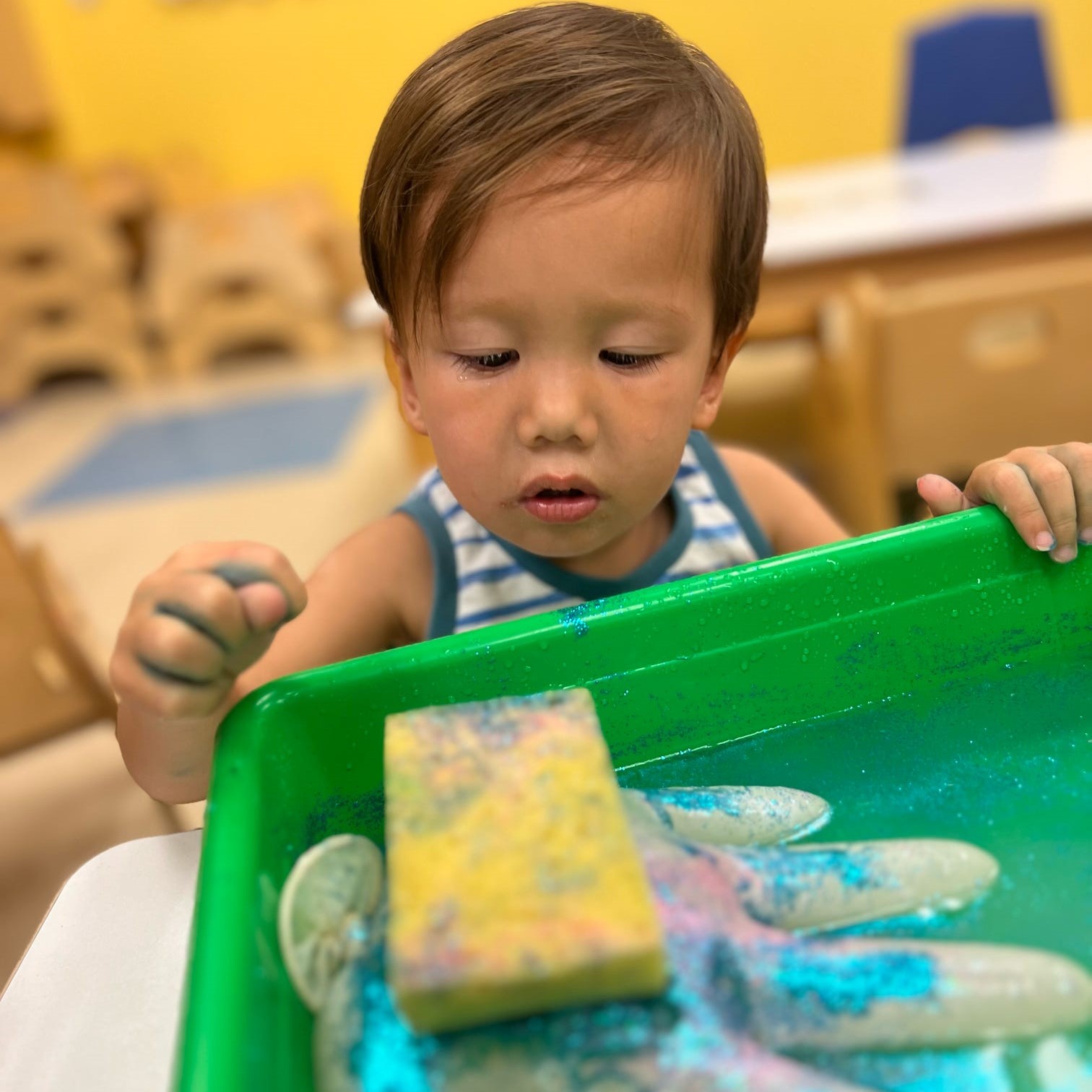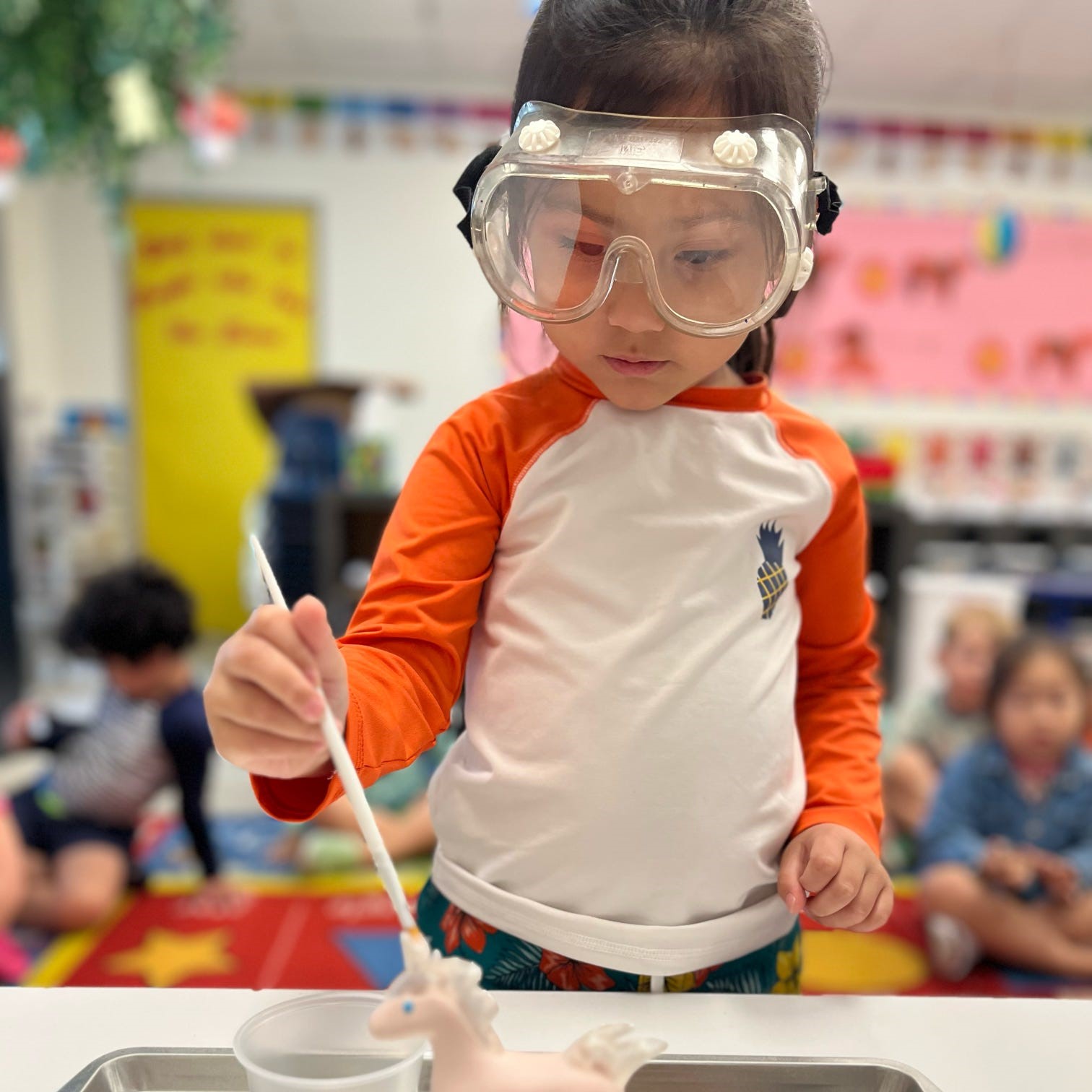




Our Philosophy
Our Philosophy
The Shenker Academy implements the Multiple Intelligence Theory which responds to the different learning styles of each individual student. This innovative educational philosophy defines eight different intelligences. We believe children who are taught through the eight intelligences become more successful at learning all subjects. When children are allowed to learn in a stimulating, multi-sensory environment, they experience many ways to learn and master almost anything. It is our belief that using the Multiple Intelligence Theory in a warm nurturing environment along with our low student/teacher ratios meets the developmental and educational needs of each child.
Gardner's Multiple Intelligence Theory
The Shenker Academy’s curriculum framework is based on the Howard Gardner’s Multiple Intelligence Theory and the four developmental domains of child development, social, emotional, cognitive, and physical.
This combined curriculum framework works hand in hand. Teachers create their lesson plans following the eight multiple intelligences that also work on the social, emotional, cognitive, and physical development for each individual child. The daily and weekly curriculum is planned around the children’s age, individual, and group needs. We want the curriculum to be planned by the teachers so that it will fit around the children’s stages of development. We do not expect the children to fit into a pre-packaged curriculum. Children are continually observed and assessed individually so that lesson planning is relevant to each child.
How does the curriculum framework work? Children are smart in different ways so therefore they learn in different ways. By creating lesson plans and curriculum to encompass all the intelligence, we give all the children an equal opportunity to excel. By broadening the curriculum to include the development of all the eight intelligences along with working on the four developmental domains of every child, we help every child be all that they can be. By teaching our students through the eight intelligences we begin to see that there is a unique pattern of intelligences of each individual child. This creates a learning environment of diverse intelligence and every child’s self worth is validated. There is not an atmosphere of the “smarter” or “dumber” child. The children enjoy the sense of success and self-worth and begin to value and have a respect for the uniqueness of others. It has been determined that the social and emotional well being of a child fuels the intellect. Research regarding early childhood brain development indicates that the social-emotional development and cognitive development work hand in hand.
The Eight Intelligences (Garnder)
The Shenker Academy’s curriculum framework is based on the Howard Gardner’s Multiple Intelligence Theory and the four developmental domains of child development, social, emotional, cognitive, and physical.
This combined curriculum framework works hand in hand. Teachers create their lesson plans following the eight multiple intelligences that also work on the social, emotional, cognitive, and physical development for each individual child. The daily and weekly curriculum is planned around the children’s age, individual, and group needs. We want the curriculum to be planned by the teachers so that it will fit around the children’s stages of development. We do not expect the children to fit into a pre-packaged curriculum. Children are continually observed and assessed individually so that lesson planning is relevant to each child.
How does the curriculum framework work? Children are smart in different ways so therefore they learn in different ways. By creating lesson plans and curriculum to encompass all the intelligence, we give all the children an equal opportunity to excel. By broadening the curriculum to include the development of all the eight intelligences along with working on the four developmental domains of every child, we help every child be all that they can be. By teaching our students through the eight intelligences we begin to see that there is a unique pattern of intelligences of each individual child. This creates a learning environment of diverse intelligence and every child’s self worth is validated. There is not an atmosphere of the “smarter” or “dumber” child. The children enjoy the sense of success and self-worth and begin to value and have a respect for the uniqueness of others. It has been determined that the social and emotional well being of a child fuels the intellect. Research regarding early childhood brain development indicates that the social-emotional development and cognitive development work hand in hand.
Our Classrooms' Layout
Our classrooms are designed to facilitate progress and growth in the four developmental domains and support the eight multiple intelligences. Learning centers are created to provide the perfect setting to implement activities that will interest and appeal to the full range of intelligence. The children are allowed to explore and engage in hands-on, concrete learning experiences by manipulating age-appropriate materials and equipment. On a daily basis, children have the opportunity to use their high ability intelligence, as well as the opportunity to practice other intelligence when approaching learning.
Children who are taught through their stronger intelligence become more successful at learning all subjects. Each of the learning centers supports and facilitate the children’s developing social skills, emotional skills, cognitive skills, and physical skills as they are learning concepts using their stronger intelligence. Centers that you will find in the classrooms of any age group are a Dramatic Play Area, a Library Center, a Block Center, a Math Center, a Science Center, a Manipulative Center, a Sensory Table, and a Creative Art Center. Below you will see how some of the centers facilitate learning and development by using the multiple intelligence theory to develop the four developmental domains.
Dramatic play guides the children to use their interpersonal and intrapersonal intelligence, linguistic intelligence, and bodily-kinesthetic intelligence. The dramatic play area also facilitates the development of the child’s social, emotional, physical, and cognitive development. By dressing into play clothes the child is using their body-kinesthetic intelligence to develop their fine motor skills when buttoning a shirt. They use their linguistic intelligence and interpersonal/intrapersonal intelligence to communicate with others regarding role-playing and by using this intelligence they are furthering the development of their social, emotional, and cognitive skills.
Center Based Learning
In the library, children will be using their interpersonal/intrapersonal intelligence, linguistic intelligence, and spatial intelligence. When they are looking at books, pretending to read, stating the “ideas” of the pictures out loud, sharing a book with a friend, comparing pictures in books to items found in the classroom all four of these intelligences are being utilized. By performing the above actions children are developing their social, emotional, cognitive, and physical skills. Sharing books with friends is a social and emotional domain. Reading “ideas” out loud is developing the cognitive domain and holding the book and turning pages develops the physical domain.
The block center is a great area for the children to use their logical-mathematical and spatial intelligence. Although they also have to use their linguistic intelligence as well if communicating to others what they are building and why. Building blocks using the logical-mathematical and spatial intelligence are developing cognitive, problem-solving skills, as well as social skills.
Science
The science center encourages children to use their naturalistic, logical-mathematical, and linguistic intelligence. All four developmental domains are being developed during the exploration of science with the teacher and/or classmates. Language is being used to talk socially with others, questions that use the logical-mathematical intelligence are being asked to help develop the cognitive thought process, and most science starts with nature so the naturalistic intelligence is being utilized while other developmental domains are strengthened.
Teachers observe and assess how children learn and what is being learned, what they need to teach and how to teach the concepts by observing and assessing the children’s actions and abilities in the centers. Teaching materials can be added or changed to further the curiosity and experiences of hands-on learning for children. Children begin to use the new knowledge of concepts and add it on to previous knowledge. Teachers can then formulate lesson plans that will extend and expand children’s learning by using the eight intelligences so the children can continue growing in the four developmental domains. Increased knowledge, skills, and abilities are the progression of using intelligence and developing the four domains.
Our Philosophy
Our Philosophy
The Shenker Academy implements the Multiple Intelligence Theory which responds to the different learning styles of each individual student. This innovative educational philosophy defines eight different intelligences. We believe children who are taught through the eight intelligences become more successful at learning all subjects. When children are allowed to learn in a stimulating, multi-sensory environment, they experience many ways to learn and master almost anything. It is our belief that using the Multiple Intelligence Theory in a warm nurturing environment along with our low student/teacher ratios meets the developmental and educational needs of each child.
Gardner's Multiple Intelligence Theory
The Shenker Academy’s curriculum framework is based on the Howard Gardner’s Multiple Intelligence Theory and the four developmental domains of child development, social, emotional, cognitive, and physical.
This combined curriculum framework works hand in hand. Teachers create their lesson plans following the eight multiple intelligences that also work on the social, emotional, cognitive, and physical development for each individual child. The daily and weekly curriculum is planned around the children’s age, individual, and group needs. We want the curriculum to be planned by the teachers so that it will fit around the children’s stages of development. We do not expect the children to fit into a pre-packaged curriculum. Children are continually observed and assessed individually so that lesson planning is relevant to each child.
How does the curriculum framework work? Children are smart in different ways so therefore they learn in different ways. By creating lesson plans and curriculum to encompass all the intelligence, we give all the children an equal opportunity to excel. By broadening the curriculum to include the development of all the eight intelligences along with working on the four developmental domains of every child, we help every child be all that they can be. By teaching our students through the eight intelligences we begin to see that there is a unique pattern of intelligences of each individual child. This creates a learning environment of diverse intelligence and every child’s self worth is validated. There is not an atmosphere of the “smarter” or “dumber” child. The children enjoy the sense of success and self-worth and begin to value and have a respect for the uniqueness of others. It has been determined that the social and emotional well being of a child fuels the intellect. Research regarding early childhood brain development indicates that the social-emotional development and cognitive development work hand in hand.
The Eight Intelligences (Garnder)
The Shenker Academy’s curriculum framework is based on the Howard Gardner’s Multiple Intelligence Theory and the four developmental domains of child development, social, emotional, cognitive, and physical.
This combined curriculum framework works hand in hand. Teachers create their lesson plans following the eight multiple intelligences that also work on the social, emotional, cognitive, and physical development for each individual child. The daily and weekly curriculum is planned around the children’s age, individual, and group needs. We want the curriculum to be planned by the teachers so that it will fit around the children’s stages of development. We do not expect the children to fit into a pre-packaged curriculum. Children are continually observed and assessed individually so that lesson planning is relevant to each child.
How does the curriculum framework work? Children are smart in different ways so therefore they learn in different ways. By creating lesson plans and curriculum to encompass all the intelligence, we give all the children an equal opportunity to excel. By broadening the curriculum to include the development of all the eight intelligences along with working on the four developmental domains of every child, we help every child be all that they can be. By teaching our students through the eight intelligences we begin to see that there is a unique pattern of intelligences of each individual child. This creates a learning environment of diverse intelligence and every child’s self worth is validated. There is not an atmosphere of the “smarter” or “dumber” child. The children enjoy the sense of success and self-worth and begin to value and have a respect for the uniqueness of others. It has been determined that the social and emotional well being of a child fuels the intellect. Research regarding early childhood brain development indicates that the social-emotional development and cognitive development work hand in hand.
Our Classrooms' Layout
Our classrooms are designed to facilitate progress and growth in the four developmental domains and support the eight multiple intelligences. Learning centers are created to provide the perfect setting to implement activities that will interest and appeal to the full range of intelligence. The children are allowed to explore and engage in hands-on, concrete learning experiences by manipulating age-appropriate materials and equipment. On a daily basis, children have the opportunity to use their high ability intelligence, as well as the opportunity to practice other intelligence when approaching learning.
Children who are taught through their stronger intelligence become more successful at learning all subjects. Each of the learning centers supports and facilitate the children’s developing social skills, emotional skills, cognitive skills, and physical skills as they are learning concepts using their stronger intelligence. Centers that you will find in the classrooms of any age group are a Dramatic Play Area, a Library Center, a Block Center, a Math Center, a Science Center, a Manipulative Center, a Sensory Table, and a Creative Art Center. Below you will see how some of the centers facilitate learning and development by using the multiple intelligence theory to develop the four developmental domains.
Dramatic play guides the children to use their interpersonal and intrapersonal intelligence, linguistic intelligence, and bodily-kinesthetic intelligence. The dramatic play area also facilitates the development of the child’s social, emotional, physical, and cognitive development. By dressing into play clothes the child is using their body-kinesthetic intelligence to develop their fine motor skills when buttoning a shirt. They use their linguistic intelligence and interpersonal/intrapersonal intelligence to communicate with others regarding role-playing and by using this intelligence they are furthering the development of their social, emotional, and cognitive skills.
Center Based Learning
In the library, children will be using their interpersonal/intrapersonal intelligence, linguistic intelligence, and spatial intelligence. When they are looking at books, pretending to read, stating the “ideas” of the pictures out loud, sharing a book with a friend, comparing pictures in books to items found in the classroom all four of these intelligences are being utilized. By performing the above actions children are developing their social, emotional, cognitive, and physical skills. Sharing books with friends is a social and emotional domain. Reading “ideas” out loud is developing the cognitive domain and holding the book and turning pages develops the physical domain.
The block center is a great area for the children to use their logical-mathematical and spatial intelligence. Although they also have to use their linguistic intelligence as well if communicating to others what they are building and why. Building blocks using the logical-mathematical and spatial intelligence are developing cognitive, problem-solving skills, as well as social skills.
Science
The science center encourages children to use their naturalistic, logical-mathematical, and linguistic intelligence. All four developmental domains are being developed during the exploration of science with the teacher and/or classmates. Language is being used to talk socially with others, questions that use the logical-mathematical intelligence are being asked to help develop the cognitive thought process, and most science starts with nature so the naturalistic intelligence is being utilized while other developmental domains are strengthened.
Teachers observe and assess how children learn and what is being learned, what they need to teach and how to teach the concepts by observing and assessing the children’s actions and abilities in the centers. Teaching materials can be added or changed to further the curiosity and experiences of hands-on learning for children. Children begin to use the new knowledge of concepts and add it on to previous knowledge. Teachers can then formulate lesson plans that will extend and expand children’s learning by using the eight intelligences so the children can continue growing in the four developmental domains. Increased knowledge, skills, and abilities are the progression of using intelligence and developing the four domains.
